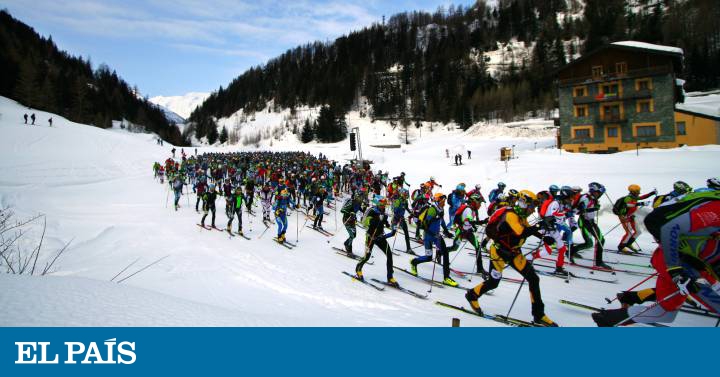MORE INFORMATION
Skiing in the domain of the great polar bear
Sölden, skiing in a 007 movie
Ski resorts are among the major victims of the pandemic.
The mobility restrictions or even the closure obligation have emptied them of alpine ski lovers.
And this, apart from the economic damages,
has caused an explosion in the practice of ski touring
.
Hundreds of alpine skiers have not given up their dose of snow this season and have adopted the most logical alternative.
Get off the slopes to increase your mastery of the entire mountain and replace the ski lifts with pivoting boots.
I had always envied backcountry skiers the privilege of being able to access the descents of huge slopes covered in a blanket of unique and virginal powder snow, although not so much the obligation to trudge up the mountain while I was transported by a comfortable and acclimatized cable car that quietly deposited me on the pinnacle of the mountain.
Is it really worth hitting a beat to enjoy a unique descent?
You can only answer this question by testing.
So that's what I did, sign up for an introductory ski touring course.
enlarge photo The author (last in line), with his companions during the ski touring course at the Valdesquí facilities (Madrid).
The first thing is to familiarize yourself with the
equipment
: leathers, bindings, boots, helmet, ice ax, crampons, blades, shovel, arva, probe, backpack, pants, textile capes and gloves.
When you see all the material on the table, the first question you ask yourself is why does all
outdoor
activity
require equipment to invade Gaul?
And the second is: won't nudism make me happier?
But once you learn what each thing is for, the rejection of complexity turns into interest and awareness that it is not that bad either.
In short, for the alpine skier, touring ski equipment is much lighter and takes up considerably less space.
The second issue is
safety in the mountains
.
Cross-country skiing is like the coming of age of the skier, who is no longer protected or under the watchful eye of those responsible for the ski resorts, where the risk on the slopes, compared to the rest of the mountain, is almost inexistent.
In the mountains one must be completely self-sufficient and know perfectly both the route to follow and the weather conditions of the day the route is going to be traveled, and have the physical and technical preparation to face every vicissitude that may occur in the land.
And of course be perfectly equipped.
Cross-country skiing is like scuba diving, 90% preparation to ensure safety.
Emancipation to immerse yourself in nature and enjoy places and experiences that ski resorts cannot offer, has its cost, and this is not as high as it seems.
The Expert's vision
Pablo Velasco
Pablo Velasco
Pablo Velasco
is a comprehensive mountain guide.
Practitioner of climbing, mountaineering, skiing, canyons or via ferratas, he has extensive training as a superior sports climbing technician, high mountain sports technician and canyoning sports technician and is director of the Mountaineering Technification Program of the Madrid Mountaineering Federation .
What does cross-country skiing bring that alpine skiing or
freeride
doesn't have
?
The experience of being able to climb a snowy mountain wherever you want, the feeling after the effort that this requires
tuning in with nature ..., and also, the gratification of the descent through untreated virgin snow
... These are such positive sensations that this sport makes you hooked and that mountain or touring skis are the ideal vehicle to move around the winter mountains.
What skier profile could cross-country skiing experience?
I recommend that alpine skiers try the tour because they already know the technique of descent.
When I have students who want to come to SKIMO courses (short for mountain skiing or cross-country skiing) I tell them to first do an alpine ski course in the resort.
The descent technique must be learned in the station, with a treated snow, with a qualified teacher who teaches us
the technique
from the first moment
and with lifts with which we can go up and down many times in a single day ... that's a lot easier to come to the introductory courses at SKIMO and worry about the technique on the rise, how you
focus
well, the progressive lap, the María lap, the use of the poles, and so on;
and then knowing that the descent is not going to be a problem ... but an enjoyment!
What are the main points to keep in mind when approaching ski touring?
In my introductory courses I always emphasize that these first items are important:
A)
Plan the activity /
Security.
1.- Route that I want to do and alternatives.
2.- Snow conditions and forecast weather.
3.- Human factor: who I go with and experience they have.
B) Necessary material:
What material do I need to carry out a ski touring activity in high mountains: Complete equipment (skis, skins, bindings, boots, poles, helmet).
Safety equipment: crampons, blades, ice ax, DVA, Shovel, Sona, the 3G (gloves, glasses, hat).
Appropriate clothing three-layer system, mountain backpack, food and drink, first aid kit and front.
What is your favorite ski route in Spain?
Carros de Foc
with skis, it is the return to the Aigüestortes National Park, for me it is one of the most beautiful routes that can be done in Spain.
What route would you like to take in the world?
I have as a project to go down the
Chimborazo volcano,
in Ecuador, with skis.
What has been the time when you have been in a hurry in cross-country skiing? And the one you have enjoyed the most?
As a professional high mountain guide I try not to find myself in very hurried moments, but sometimes, in the Sierra del Guadarrama or in the Sierra Nevada, the snow conditions are especially delicate because there are freezing rain phenomena that turn areas into ice, sometimes going from skis to crampons has been a risky undertaking.
I have many memories of enjoyment in the
Macizo de las Maladetas-Aneto
, doing Carros de Foc or skiing in El Valle de Tena near my rural house, although in Guadarrama if you go up on the right day, I have also had unforgettable skis ...
What equipment would you recommend to start ski touring?
I think you have to look for a versatile team ... neither too heavy nor too light.
Atomic for me currently has a material with a very good quality / price ratio.
The range of
backland ski touring with 85 cm skate
seems to me a very good choice.
In view of the theory, it is
time for praxis
.
Mountain gear is not a big problem for an average alpine skier.
What's more, from the point of view of comfort it is an obvious improvement.
With the boots you can walk as if they were hiking boots and not at the Frankenstein gait so characteristic of downhill boots.
Its anchoring on the ski is simple, and although it pivots on the tip when in touring mode, there are no sensations too strange to make practice difficult.
The first thing to do, after putting on your boots, is to place the sealskins on the soles of the boards, that huge adhesive tape that will allow the ski to grip the snow and climb slopes.
It is 10 seconds for the competitive
skimo
(mountain skier), 4 minutes for any mountain skier, and 5 minutes for the perfectionist.
And then slide on the skis.
The technique requires dragging "the big toe through the snow" so that the ski does not lose contact with the surface, but the equipment weighs so little that lifting the boot and board is almost an unconscious action.
Bad business.
On the ascent, so many steps are taken that the only thing that contributes is load to the quadriceps.
Concentrate on sliding the ski and not lifting it.
When moving forward, the sealskin hairs are flattened and allow a smooth glide, and when the foot is pressed and traction arises these same hairs dig into the snow, and the ski becomes a perfectly stable step.
One of the best sensations that alpine skiers can experience
, knowing how tiring it is to climb a slope on skis.
Of course, there comes a point where the degree of steepness of the slope forces the ascent to change from vertical to zigzag.
And in certain circumstances, making the change of direction on the slope requires resorting to the “
Maria turn
”.
A maneuver executed in three phases, quite simple, that resembles the fifth position of ballet, and allows you to turn the direction of movement 180º.
Assimilate the new techniques and implement them causes the climb to be tiring.
Cross-country skiing is a tough exercise at times, but yes, very rewarding.
However, it is like hiking,
the level of effort required varies depending on the difficulty of the chosen route
, and the ease with which one takes the different sections.
But I already warn you that after a season of cross-country skiing, your legs and torso will become as if they were carved out of wood.
You get to the top tired, it is true, it has nothing to do with the pleasant chairlift, where you can meditate or take selfies to touch the noses of your coworkers.
And while it's a rewarding exhaustion that triggers endorphins, it's still exhaustion.
On a day of backcountry skiing, you have to be very strong to make ascents of about 300 meters of unevenness and then descend repeatedly.
And speaking of descents, once the summit is reached, it is time to enjoy the descent.
On mountain skiing descents, it must be taken into account that one already has a degree of fatigue, the equipment, fantastic for climbing due to its light weight, is now not so good for the descent, compared to boards and ski boots. alpine, and the snow is not prepared by the gentle snow-grooming machines of the stations.
You
have to be used to your gear and have the expertise to go down different types of snow
.
And how do you get the expertise and control of the kit?
With practice.
The karatecas affirm that "1,000 days of training for the initiate, 10,000 days for the master."
And the safest environment to train cross-country skiing until enough technique is assimilated to go out on the mountain are the ski resorts. What a beautiful irony!
Many resorts have already begun to set up sections for the practice of mountain skiing in their domains.
Perfect facilities to refine technique and undertake descents with the new material in a much safer environment.
And like any new activity, ski mountaineering has brought new problems in the resorts that, from my point of view, are easily remedied.
It is enough to comply at all times with the rules of the ski touring facilities.
Once you have obtained control over your own equipment, the skill to go out to the mountains and the physical form to enjoy the day of skiing, outside the limits of the stations, wonderful natural landscapes await you and access to a snow of the one that cannot be enjoyed in any other way.
For me, cross-country skiing is
the key that opens up new routes through the Pyrenees, new adventures through the plains of Lapland, or exhilarating descents through the Norwegian mountains that line the fjords.
But of course it ensures you can ski if next season the stations close or confine us.
Basic Equipment
enlarge photo
Wedze MT90 Mountain Touring Skis (Decathlon)
Wide skis that provide a good downhill feel on all types of snow.
The price includes bindings and skins.
RRP € 649.99
Hawx Prime XTD 100 GW boot by Atomic
Very versatile and comfortable, they are
suitable
for both alpine descent and ski touring, which makes them a fantastic tool for descents.
PV P € 339.99
Stowe trousers by Ternua
A multifunction for winter days.
It is designed for ski mountaineering, mountaineering and
trekking
.
Insulating and breathable, its construction allows great mobility.
RRP € 169.95
Ternua Dynamic Jacket
Jacket with hood made of brushed and bi-elastic Storm fleece fabric.
Very breathable and highly resistant to wind and water.
PV P € 189.95
Mountain Skiing
Book . Basic
Manual Manual that will help to know all the keys to get started in this exciting sport of mountain skiing.
RRP € 16.15
Mythical Descents
Book
Long descents, classic ramps, vertical falls and vertigo slopes.
An extensive and impressive panorama of the best ski destinations located all over the planet.
RRP € 23.90
You can follow EL PAÍS Sports on Facebook, Twitter or subscribe to the Newsletter here.











